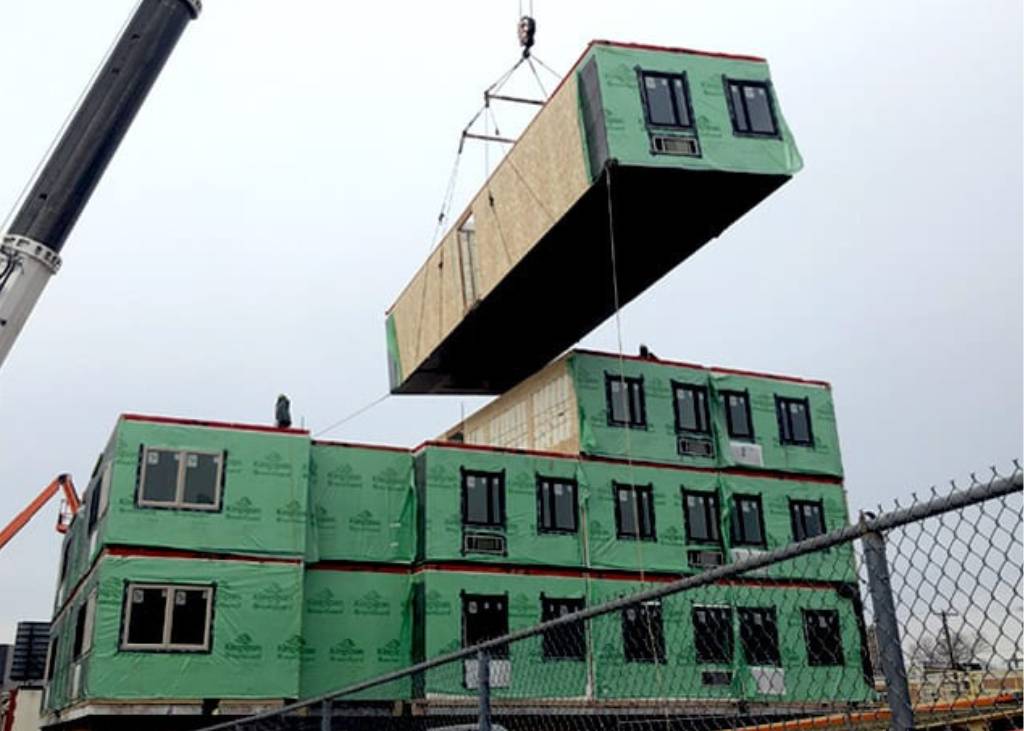The Advantages and Challenges of Modular Construction

There’s a strong trend in the real estate industry toward building more things away from the construction site. Modular construction is one approach. Real Projectives® has been involved in multiple modular construction projects throughout the United States, most recently with a new apartment building in downtown Philadelphia.
For that construction project, designers and contractors planned to fabricate 75 modules about 100 miles away from the site, truck them into the city, and then stack them on top of each other to complete a six-story apartment building. If you’re contemplating this kind of approach on your next project, we’d like to share some advantages and challenges to help your project be completed successfully.
What is Modular Construction?
To get us on the same page, we believe it’s important to think of the answer to the question ‘what is modular construction’ first and foremost. The easy answer is: think of modular as a method of construction rather than a unique product type. Modular construction is the process in which a building (whether it be an apartment, business building, and even homes are now starting to be built with shipping containers) is constructed off-site, under controlled conditions, using the same materials and designing to the same codes and standards as conventionally built facilities – but in about half the time. The process consists of buildings produced in modules to be later put together on site.
For centuries, traditional construction brought all the raw materials — like 2x4s and flooring — to the building site for tradespeople to cut and assemble at the project location. With off-site construction in general, and with modular construction specifically, large portions of the project are fabricated away from the job site. Assembly can take place almost anywhere: from the next town over to an entirely different country. The assembled modules are then shipped and placed on the job site for a completed building.
While you may hear others describe this as a “new” or “modern” method, it has been used in multiple industries for decades. More recently, it’s been getting press for multi-family (apartments), hotel and commercial uses. What makes these projects modular is that the “boxes” that leave the factory are three-dimensional structures with floor, walls and ceiling. They contain most of the interior finishes and fixtures already installed. Some modular companies use common stick-building methods in their warehouses; others use highly automated robotic assembly lines. There are other flavors of off-site construction that are not modular, but we’ll explore them in a future article.
The Advantages of Modular Construction
Let’s start with the many advantages and benefits to modular construction.
1. Saves Time
An obvious one is that modular construction allows a chunk of the work to be made in a factory while sitework and foundations are simultaneously performed on the site. This time-saving benefit keeps the project on schedule and speeds up construction time while still being efficient. There is potential to save 30 to 60 percent of overall schedule through a modular approach.
2. No Possibility of Weather Delay
Furthermore, by fabricating the modules inside a controlled environment, worries about weather delaying construction of the modular units is virtually eliminated. It also provides workers safer and more comfortable conditions to be more productive and produce a higher quality product. Also, the modules arrive on-site usually outfitted with flooring, cabinets, counters, plumbing and electrical fixtures, and appliances, thereby needing little effort and time to be ready for use.
3. No Need to Store Materials
Another advantage of modular construction involves storage of materials. When a site is tight on space, for instance in a compact urban setting like Philadelphia, staging and moving materials around is difficult. This causes clutter, slows down work and creates theft concerns. By building the modules in a factory, construction sites can remain cleaner and safer, and provide more space to work and move around freely.
4. Lower Labor Costs
An important and potentially controversial advantage involves economics of labor. Skilled labor is in short supply for construction in most places and can be very expensive in cities for a variety of reasons. Without getting into politics, this leads to real challenges when trying to get a building constructed for a given budget and timeline. Modular allows those coveted skilled workers to remain in fixed locations with controlled and safer conditions as mentioned. Modular plants can be located to attract those competitive workers and take advantage of important access to raw materials and logistic connections, like highways and rail lines, common in other industries, such as automotive and technology products. Savings on labor can vary widely, but there is a potential for up to 25 percent on construction costs.
5. Lower Volume of Waste
According to a recent UK study, up to a 90% reduction in materials can be achieved with modular building. With the environment being a growing concern in the construction industry, modular strategies are becoming more popular to limit the amount of waste on each project. There are even efforts to maximize recycling within factories that put the building portions together.
The Challenges of Modular Construction
Modular construction sounds progressive and remarkably advantageous. Yet, as with other construction methods, there are some real challenges that can affect success or failure of your modular project.
1. Mass Production / Limited Variety
First, a modular (think mass production) approach on scale is better the more uniform and repetitive the spaces and products. So naturally, apartment buildings and hotels are likely candidates if each unit can be standardized and stacked. At this stage of technology, trying to create distinct or non-repetitive modules reduces, and potentially defeats, the time and cost advantages for both buyer and supplier parties.
2. Higher Amount of Complex Decisions / Front Loaded Design
Second, modular demands that more decisions and greater design and engineering be completed up front in the process. It requires architects, engineers and contractors to be familiar with the intricacies of the modular fabrication and erection stages. For instance, the taller the building (higher modules stacked) the more attention is needed to how they are connected together to be aligned and how both modules and the exterior skin will allow for compression. (The weight of stacked modules can actually crush wood below.) This front-loaded design process forces buyers and owners to make final selections on things like finishes and appliances so they can be purchased well before the work even begins. Those of you familiar with the construction business may see this as an advantage: You know that changes made late in the process can be a headache.
3. Approval Process Can Be Complicated
Third, the approvals process can be complicated. No matter how they are constructed, all projects must meet federal, state and local laws and codes. However, the codes that are applicable change based on method. Some states and local jurisdictions are more favorable to modular production than others. Ideally, the modules are made subject to state codes (such as Pennsylvania Industrialized Housing Act) and can be inspected and completed at the factory with only connections and work performed on site subject to local inspection. On the contrary, states like Maryland require local inspections of systems preventing walls from being closed and finishes applied until on site. In places with strong union influence, how contractors navigate trade relationships can further complicate both the approval and execution phases.
4. Risk is on Few Suppliers
Additionally, you’re concentrating execution risk for the project into one or a few suppliers. Modular manufacturers have mostly focused on making single-family homes as their bread-and-butter products. While the number of companies producing commercial and multi-family products is growing, it’s still very limited in those that are interested, capable and have the financial capacity to deliver. Buyers, whether they’re owners or general contractors, must perform full diligence on companies before entering into an agreement that puts all their eggs in one basket. And, they must continue to be diligent following up throughout their work. Even if bonded, it would have to be a huge disaster to switch to another manufacturer in the middle of a project.
5. Transportation Costs & Risk
Then there’s the transportation risk. Since modules are prefabricated in a factory miles from the job site, they need to be transported either directly to the job site or staged at a place nearby and then set in place. The transporters and riggers must be extremely careful with each module as one mishap during transportation and the entire module could need significant repairs or replacement. This could potentially hold up an entire sequence of installation. On our Philadelphia project delivery, staging and set went fairly smoothly with limited cracking of interior drywall due to lifting the modules into place. This damage was easily repairable, so not much to worry about there.
It’s important for the transportation and rigging companies to spend serious effort in tracing down the roads and plotting the logistics of moving the modules throughout their entire journey. They can’t get hung up by bridges, tight turns, traffic problems, crane setup and temporary road closure permits. Module sizes are usually limited first by allowable size on road (maybe 10 feet wide by 70 feet long) and capacity of available crane (to lift as much as 25 tons) across the depth of a project site. Make sure you also have your insurance advisor work with a broker and carrier familiar with the many related risks to off-site construction.
6. Difficult Financing Process
Another challenge involves financing. Since modular construction requires purchasing and making things on a faster timeline, the bills are usually much larger earlier in the construction period than investors and lenders may be used to seeing and paying. Therefore, take time to work with the manufacturer and contractor to understand the amounts and timing of anticipated funding (create a projection by month) and update it as the project unfolds. This will help to make sure that adequate monies are available to keep the job going and prevent mechanic’s liens. A related item is that someone representing the contractor, owner and bank should plan to visit the factory at stages of production to make sure that funds are being invested into your modules and not into somebody else’s (this is applicable for any type of funding of stored materials and pre-fabricated purchases).
While modular construction is beneficial in certain circumstances, it’s not without challenges and isn’t the answer for every project. However, we’re certain that you’ll be seeing a lot more modular and off-site construction performed into the future.
Real Projectives® can help manage any type of construction project, including modular construction & building, to bring exceptional results. Call us at 888.357.7342 to find out more.


